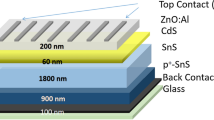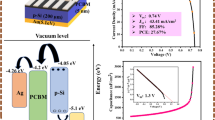Abstract
Here, we report an enhanced photovoltaic (PV) performance including open circuit voltage (Voc), short circuit current (Jsc), fill factor (FF) and power conversion efficiency (PCE) of Ni/PEDOT:PSS/n-Si/n-ZnO/Al heterojunction solar cells (HSCs) via numerical simulation. In this structure, n-ZnO is introduced at the interface of Si and Al as back surface field (BSF). Firstly, influence of various device parameters, such as thickness of Si, and PEDOT:PSS layers, carrier concentrations and defect density of Si and PEDOT:PSS on the PV performances of device without ZnO-BSF has been investigated numerically employing Solar Cell Capacitance Simulator (SCAPS-1D) software to find the best possible performance parameters of such HSCs. The maximum PCE of the optimized PEDOT:PSS/n-Si HSC without BSF is achieved as 24.26% with Voc: 0.647 V, Jsc: 44.87 mA/cm2, and FF: 83.52% for tSi of 150 μm with Nd of 1 × 1016 cm−3. After introducing the ZnO-BSF layer of thickness and carrier concentration of 20 nm and 1 × 1017 cm−3 respectively, the significant enhancement in the PCE of the device has been observed. The PCE as high as 31.37% with Voc: 0.784 V, Jsc: 45.31 mA/cm2, and FF: 88.35% was obtained for an optimized ZnO-BSF layer. The PCE is more than 7% (absolute) higher than that of without ZnO-BSF layer. The significant improvement in the PV parameters, primarily in Voc by ~ 137 mV was caused by high built-in potential developed across the junction after insertion of the ZnO-BSF layer. The quantum efficiency of the device further supported the enhanced performance resulting from the reduced recombination of charge carriers at the rear side after n-ZnO-BSF layer. The present numerical simulation study proposes a great potential of ZnO as the BSF layer for the enhanced PV performance of PEDOT:PSS/n-Si based HSCs.
Graphical abstract

Highlights
-
Simulation study of PEDOT:PSS/Si heterojunction solar cells (HSCs) by SCAPS-1D.
-
Investigation of Si and PEDOT:PSS thickness, carrier and defect concentrations on PCE.
-
Significant enhancement in solar cell performance by ZnO-BSF based device structure.
-
Maximum PCE of > 31.0% and Voc 0.78 V in ZnO-BSF based HSCs predicted by simulation.
-
Enhancement in Voc explained by built-in potential developed across rear junction.
Similar content being viewed by others
Data Availability
All data generated or analysed during the study are included in this article.
References
Iyer A, Hack J, Trujillo DAA, Tew B, Zide J, Opila R (2018) Effects of co-solvents on the performance of PEDOT:PSS films and hybrid photovoltaic devices. Appl Sci 8:2052. https://doi.org/10.3390/app8112052
Kasahara K, Hossain J, Harada D, Ichikawa K, Ishikawa R, Shirai H (2018) Crystalline-Si heterojunction with organic thin-layer (HOT) solar cell module using poly(3,4-ethylenedioxythiophene):poly(styrene sulfonate) (PEDOT:PSS). Sol Energy Mater Sol Cells 181:60–70. https://doi.org/10.1016/j.solmat.2017.10.016
Yu LM, Chen T, Feng N, Wang R, Sun T, Zhou Y, Wang H, Yang Y, Lu ZH (2020) Highly conductive and wettable PEDOT:PSS for simple and efficient organic/c-Si planar heterojunction solar cells. Sol RRL 4:1900513. https://doi.org/10.1002/solr.201900513
He J, Gao P, Ling Z, Ding L, Yang Z, Ye J, Cui Y (2016) High efficiency silicon/organic heterojunction solar cells with improved junction quality and interface passivation. ACS Nano 10:11525–11531. https://doi.org/10.1021/acsnano.6b07511
Yameen M, Srivastava SK, Singh P, Turan K, Prathap P, Vandana RCMS, Singh PK (2015) Low temperature fabrication of PEDOT:PSS/micro-textured silicon-based heterojunction solar cells. J Mater Sci 50:8046–8056. https://doi.org/10.1007/s10853-015-9372-7
Singh P, Srivastava SK, Sivaiah B, Prathap P, Rauthan CMS (2018) Enhanced photovoltaic performance of PEDOT:PSS/Si solar cells using hierarchical light trapping scheme. Sol Energy 170:221–233. https://doi.org/10.1016/j.solener.2018.05.048
Singh P, Srivastava SK, Sivaiah B, Laxmi S, Prathap P, Rauthan CMS (2018) Light intensity dependent characteristics of micro-textured Si/PEDOT: PSS heterojunction solar cell. J Mater Sci: Mater Electron 29:5087–5097. https://doi.org/10.1007/s10854-017-8472-3
Srivastava A, Sharma D, Kumari P, Dutta M, Srivastava SK (2021) Highly efficient PEDOT:PSS/silicon hybrid solar cells via effective surface microengineering of low-cost solar-grade silicon wafers. ACS Appl Energy Mater 4:4181–4198. https://doi.org/10.1021/acsaem.1c00511
Kanchan K, Sahu A, Kumar B (2022) Numerical simulation of copper indium Gallium diselenide solar cell with ultra-thin BaSi2 back surface field layer using non-toxic In2Se3 buffer layer. Silicon. https://doi.org/10.1007/s12633-022-01983-2
Chen L, Gao Z, Zheng Y, Cui M, Yan H, Wei D, Dou S, Ji J, Jia E, Sang N, Liu K, Ding X, Li Y, Li M (2018) 14.1% efficiency hybrid planar-Si/organic heterojunction solar cells with SnO2 insertion layer. Sol Energy 174:549–555. https://doi.org/10.1016/j.solener.2018.09.035
Muchahary D, Priyanka K, SaiRam L, Prahitha A, Kollem S (2021) Performance enhancement through optimization of metal oxide electron transport layer in hybrid solar cell. Optik 248:168102. https://doi.org/10.1016/j.ijleo.2021.168102
Rawat A, Sharma M, Chaudhary D, Sudhakar S, Kumar S (2014) Numerical simulations for high efficiency HIT solar cells using microcrystalline silicon as emitter and back surface field (BSF) layers. Sol Energy 110:691–702. https://doi.org/10.1016/j.solener.2014.10.004
Kumari P, Srivastava A, Sharma RK, Sharma D, Srivastava SK (2022) In: Khan (ed), ZH (ed), Nanomaterials for Innovative Energy Systems and Devices. Materials Horizons: From Nature to Nanomaterials. Springer Nature, Singapore, 173–241 https://doi.org/10.1007/978-981-19-0553-7_6
Fan Z, Lu JG (2005) Zinc oxide nanostructures: Synthesis and properties. J Nanosci Nanotechnol 5:1561–1573. https://doi.org/10.1166/jnn.2005.182
Liu P, Gao P, Liu X, Wang H, He J, Yang X, Zeng Y, Yan B, Fang J, Ye J (2018) High-performance organic-silicon heterojunction solar cells by using Al-doped ZnO as cathode interlayer. Sol RRL 2:1700223. https://doi.org/10.1002/solr.201700223
Wang Z, Yang Y, Zhang L, Lin H, Zhang Z, Wang D, Peng S, He D, Ye J, Gao P (2018) Modulation-doped ZnO as high-performance electron-selective layer for efficient silicon heterojunction solar cells. Nano Energy 54:99. https://doi.org/10.1016/j.nanoen.2018.10.010
Xia Z, Li P, Liu Y, Song T, Bao Q, Lee ST, Sun B (2017) Black phosphorus induced photo-doping for high-performance organic-silicon heterojunction photovoltaics. Nano Res 10:3848–3856. https://doi.org/10.1007/s12274-017-1598-z
Mondal BK, Mostaque SK, Rashid MdA, Kuddus A, Shirai H, Hossain J (2021) Effect of CdS and In3Se4 BSF layers on the photovoltaic performance of PEDOT:PSS/n-Si solar cells: Simulation based on experimental data. Superlattices Microstruct 152:106853. https://doi.org/10.1016/j.spmi.2021.106853
Sun Y, Yang Z, Gao P, He J, Yang X, Sheng J, Wu S, Xiang Y, Ye J (2016) Si/PEDOT:PSS hybrid solar cells with advanced antireflection and back surface field designs. Nanoscale Res Lett 11:356. https://doi.org/10.1186/s11671-016-1560-0
Islam MR, Azam MG (2020) Enhanced photocatalytic activity of Mg-doped ZnO thin films prepared by sol–gel method. Surf Eng 37:1–9. https://doi.org/10.1080/02670844.2020.1801143
Margalith T, Buchinsky O, Cohen DA, Abare AC, Hansen M, DenBaars SP, Coldren LA (1999) Indium tin oxide contacts to gallium nitride optoelectronic devices. Appl Phys Lett 74:3930–3932. https://doi.org/10.1063/1.124227
Burgelman M, Decock K, Khelifi S, Abass A (2013) Advanced electrical simulation of thin film solar cells. Thin Solid Films 535:296–301. https://doi.org/10.1016/j.tsf.2012.10.032
Basak A, Singh UP (2021) Numerical modelling and analysis of earth abundant Sb2S3 and Sb2Se3 based solar cells using SCAPS-1D. Sol Energy Mater Sol Cells 230:111184. https://doi.org/10.1016/j.solmat.2021.111184
Kumar M, Raj A, Kumar A, Anshul A (2020) An optimized lead-free formamidinium Sn-based perovskite solar cell design for high power conversion efficiency by SCAPS simulation. Opt Mater 108:110213. https://doi.org/10.1016/j.optmat.2020.110213
Widianto E, Shobih RES, Triyana K, Nursam NM, Santoso I (2021) Performance analysis of carbon-based perovskite solar cells by graphene oxide as hole transport layer: Experimental and numerical simulation. Opt Mater 121:111584. https://doi.org/10.1016/j.optmat.2021.111584
Bal SS, Basak A, Singh UP (2022) Numerical modelling and performance analysis of Sb-based tandem solar cell structure using SCAPS-1D. Opt Mater 127:112282. https://doi.org/10.1016/j.optmat.2022.112282
Bendib T, Bencherif H, Abdi MA, Meddour F, Dehimi L, Chahdi M (2020) Combined optical-electrical modeling of perovskite solar cell with an optimized design. Opt Mater 109:110259. https://doi.org/10.1016/j.optmat.2020.110259
Andreani LC, Bozzola A, Kowalczewski P, Liscidini M, Redorici L (2019) Silicon solar cells: toward the efficiency limits. Adv Phys-X 4:1548305. https://doi.org/10.1080/23746149.2018.1548305
Subramanian M, Nagarajan B, Ravichandran A, Betageri VS, Thirunavukkarasu GS, Jamei E, Seyedmahmoudian M, Stojcevski A, Mekhilef S, Reddy VRM (2022) Optimization of effective doping concentration of emitter for ideal c-Si solar cell device with PC1D simulation. Curr Comput-Aided Drug Des 12:244. https://doi.org/10.3390/cryst12020244
Watahiki T, Kobayashi Y, Morioka T, Nishimura S, Niinobe D, Nishimura K, Tokioka H, Yamamuka M (2016) Analysis of short circuit current loss in rear emitter crystalline Si solar cell. J Appl Phys 119:204501. https://doi.org/10.1063/1.4951003
Fu H, Zhao Y (2018) In: Huang J, Kuo H-C, Shen S-C (Ed) Nitride semiconductor light emitting diodes (LEDs), 2nd edn, Materials, technologies and applications. Woodhead publishing, United States, 299–325 https://doi.org/10.1016/B978-0-08-101942-9.00009-5
Memarian N, Minbashi M, Mehrabad MJ (2016) An investigation of high performance heterojunction silicon solar cell based on n-type Si substrate. J Nano-Electron Phys 8:04058 https://doi.org/10.21272/jnep.8(4(2)).04058
Nithya KS, Sudheer KS (2022) Device modelling and optimization studies on novel ITIC-OE based non-fullerene organic solar cell with diverse hole and electron transport layers. Opt Mater 123:111912. https://doi.org/10.1016/j.optmat.2021.111912
Ferdiansjah, Faridah, Mularso KT (2018) Analysis of back surface field (BSF) performance in P-type and N-type monocrystalline silicon wafer. E3S Web Conf 43:01006 https://doi.org/10.1051/e3sconf/20184301006
https://www.pveducation.org/pvcdrom/solar-cell-operation/quantum-efficiencyhttps://www.pveducation.org Accessed 24 June 2022
Hossain J, Moon Md MA, Mondal BK, Halim MA (2021) Design guidelines for a highly efficient high-purity Germanium (HPGe)-based double-heterojunction solar cell. Opt Laser Technol 143:107306. https://doi.org/10.1016/j.optlastec.2021.107306
Mostaque SK, Mondal BK, Hossain J (2022) Theoretical insight into the enhancement of longer wavelength light absorption in silicon solar cell with multilevel impurities. Results Opt 8:100250. https://doi.org/10.1016/j.rio.2022.100250
Acknowledgements
Authors are grateful to Director, CSIR-National Physical Laboratory, New Delhi India for kind support. Premshila Kumari highly acknowledges National Renewable Energy Fellowship Ministry of New and Renewable Energy (NREF-MNRE), Govt. of India (grant code: 342-12/5/2019-HRD) for the research fellowship. U.P., D.S. and A.S. also acknowledge the research fellowships from University Grants Commission (UGC) (NTA Ref. No. 191620050801), Council of Scientific & Industrial Research (CSIR), India (grant code: 31/ 001(0623)/2019-EMR-I), and Department of Science and Technology (DST), Govt. of India (Inspire fellowship, grant code: DST/INSPIRE/Fellowship/2018/IF 180040). respectively. Authors also thank Professor Marc Burgelman, University of Gent, Belgium, for providing SCAPS simulation software.
Funding
Authors, Premshila Kumari, Urvashi Punia, Deepak Sharma, and Avritti Srivastava received research fellowships from National Renewable Energy Fellowship Ministry of New and Renewable Energy (NREF-MNRE), Govt. of India (grant code: 342–12/5/2019-HRD); University Grants Commission (UGC) (NTA Ref. No. 191620050801); Council of Scientific and Industrial Research (CSIR), Govt. of India (grant code: 31/001(0623)/2019-EMR-I); and Department of Science and Technology (DST), Govt. of India (Inspire fellowship, grant code: DST/INSPIRE/Fellowship/2018/ IF 180040) respectively.
Author information
Authors and Affiliations
Contributions
Premshila Kumari: Simulation work, data collection and analysis, writing manuscript first draft; Urvashi Punia: Data collection and analysis; Deepak Sharma: Assisted in data analysis and rearranging the manuscript first draft; Avritti Srivastava: Assisted in data analysis and rearranging the manuscript first draft; Sanjay K. Srivastava: Conceptualization, review & editing, resources, supervision. All authors read and approved the final manuscript.
Corresponding author
Ethics declarations
Ethics Approval
Not Applicable.
Consent to Participate
Not Applicable.
Consent for Publication
Not Applicable.
Competing Interests
Authors declare no conflict of interest directly or indirectly related to the work submitted for publication.
Disclosure of Potential Conflicts of Interest
The authors have no relevant financial or nonfinancial interests to disclose.
Research involving Human Participants and/or Animals
Not Applicable.
Informed Consent
Not Applicable.
Additional information
Publisher's Note
Springer Nature remains neutral with regard to jurisdictional claims in published maps and institutional affiliations.
Rights and permissions
Springer Nature or its licensor holds exclusive rights to this article under a publishing agreement with the author(s) or other rightsholder(s); author self-archiving of the accepted manuscript version of this article is solely governed by the terms of such publishing agreement and applicable law.
About this article
Cite this article
Kumari, P., Punia, U., Sharma, D. et al. Enhanced Photovoltaic Performance of PEDOT:PSS/Si Heterojunction Solar Cell with ZnO BSF Layer: A Simulation Study using SCAPS-1D. Silicon 15, 2099–2112 (2023). https://doi.org/10.1007/s12633-022-02163-y
Received:
Accepted:
Published:
Issue Date:
DOI: https://doi.org/10.1007/s12633-022-02163-y




